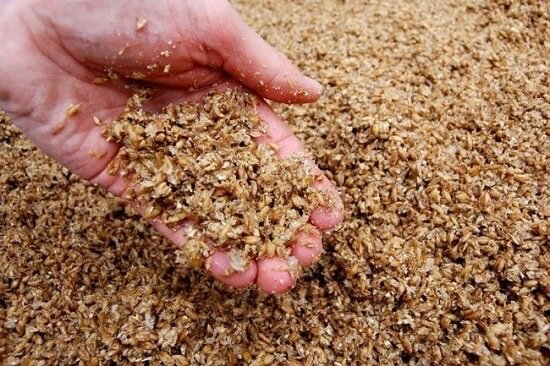 Image 1 of 4
Image 1 of 4

 Image 2 of 4
Image 2 of 4

 Image 3 of 4
Image 3 of 4

 Image 4 of 4
Image 4 of 4





Wet Brewers' Grain
Feed Characteristics
Wet brewers’ grains (WBG) are a high protein source and have a high content of total digestible nutrients (TDN) due to the digestibility of the available fiber. This high concentration of fiber of WBG is because the starches and sugars are removed from the barley grain during the malting process, leaving mainly the structural cell wall carbohydrates of cellulose and hemicellulose. The energy value of WBG is approximately 71 to 75% TDN, compared to corn, which has a TDN value of 88%. This energy is mainly derived from the highly digestible fiber in WBG. Additionally, WBG contains 7 to 10% crude fat, which contributes to the total energy value of WBG.
Wet brewers’ grains are a good source of protein with a crude protein content that ranges from 17 to 28%. The protein is mainly located in the germ portion of the spent grain and is digested to a limited extent in the rumen and to a greater extent in the small intestine. The concentration of rumen degradable protein ranges from 28 to 43% with a mean of 35%, indicating that WBG is a good source of undegradable rumen or “bypass protein.”
Wet brewers’ grains are low in calcium and potassium, similar to other cereal grains. The calcium: phosphorus ratio is inverted compared to the National Research Council recommendation of 7:1 to 1:1. Therefore, more phosphorus is supplied relative to calcium from WBG. A well-balanced mineral supplement should be provided when using WBG in diets to avoid the adverse effects of decreased growth performance experienced when this ratio is not correctly balanced.
Considerations for Use
Wet brewers’ grains contain a large concentration of water (mean = 74%), which requires some special consideration before its utilization as a feed resource. Because of the high water content of WBG, proper storage is typically an issue. WBG exposed to air will have a finite feedout period of usually only a few days. However, WBG has a high ability to be fermented and therefore increases the storage life. Under normal circumstances, the WBG will form a crust at the top of the storage barrel (the top few inches). This crust naturally forms a barrier that blocks air from penetrating the actively fermenting WBG. To reduce insect infestation, care should be taken to cover WBG with a physical barrier of plastic film. Bailey Bros provides a propriatary plastic film or shield. The shield is made of ultraviolet protective plastic that reduces the potential of feed spoilage by blocking the air and sun. With proper care, our feeders have extended the storage life of WBG for several weeks.
Feeding Guidelines
Estimating daily feed intakes should be based on the formulation of a complete feed ration. WBG is best used with other feeds that meet the animal’s total feed requirements.
Feed Characteristics
Wet brewers’ grains (WBG) are a high protein source and have a high content of total digestible nutrients (TDN) due to the digestibility of the available fiber. This high concentration of fiber of WBG is because the starches and sugars are removed from the barley grain during the malting process, leaving mainly the structural cell wall carbohydrates of cellulose and hemicellulose. The energy value of WBG is approximately 71 to 75% TDN, compared to corn, which has a TDN value of 88%. This energy is mainly derived from the highly digestible fiber in WBG. Additionally, WBG contains 7 to 10% crude fat, which contributes to the total energy value of WBG.
Wet brewers’ grains are a good source of protein with a crude protein content that ranges from 17 to 28%. The protein is mainly located in the germ portion of the spent grain and is digested to a limited extent in the rumen and to a greater extent in the small intestine. The concentration of rumen degradable protein ranges from 28 to 43% with a mean of 35%, indicating that WBG is a good source of undegradable rumen or “bypass protein.”
Wet brewers’ grains are low in calcium and potassium, similar to other cereal grains. The calcium: phosphorus ratio is inverted compared to the National Research Council recommendation of 7:1 to 1:1. Therefore, more phosphorus is supplied relative to calcium from WBG. A well-balanced mineral supplement should be provided when using WBG in diets to avoid the adverse effects of decreased growth performance experienced when this ratio is not correctly balanced.
Considerations for Use
Wet brewers’ grains contain a large concentration of water (mean = 74%), which requires some special consideration before its utilization as a feed resource. Because of the high water content of WBG, proper storage is typically an issue. WBG exposed to air will have a finite feedout period of usually only a few days. However, WBG has a high ability to be fermented and therefore increases the storage life. Under normal circumstances, the WBG will form a crust at the top of the storage barrel (the top few inches). This crust naturally forms a barrier that blocks air from penetrating the actively fermenting WBG. To reduce insect infestation, care should be taken to cover WBG with a physical barrier of plastic film. Bailey Bros provides a propriatary plastic film or shield. The shield is made of ultraviolet protective plastic that reduces the potential of feed spoilage by blocking the air and sun. With proper care, our feeders have extended the storage life of WBG for several weeks.
Feeding Guidelines
Estimating daily feed intakes should be based on the formulation of a complete feed ration. WBG is best used with other feeds that meet the animal’s total feed requirements.



